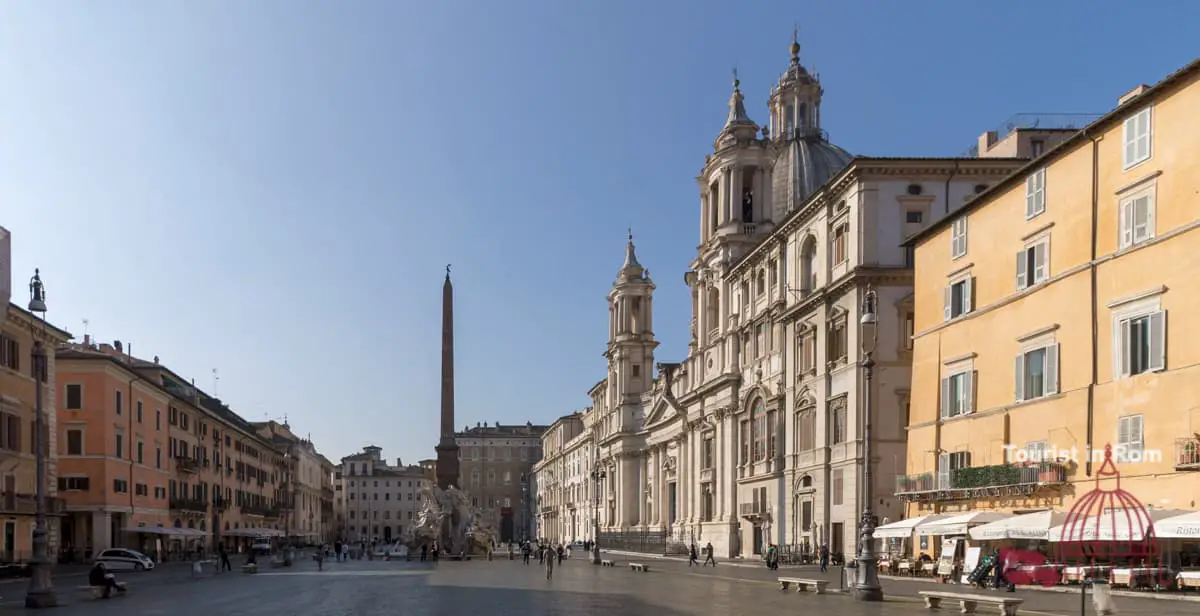Piazza Navona is the most famous square in Rome and a must for tourists. It combines works of art, fountains and buildings of great historical and cultural value.
Piazza Navona in Rome, one of the most famous and picturesque squares in Rome, has a timeless elegance and a touch of Baroque splendor. This sprawling piazza, which was a stadium in ancient times, has undergone a fascinating transformation over the centuries.
The Piazza is famous for the imposing fountain by Gian Lorenzo Bernini, the palace of the noble Pamphili family and the church of Sant’Agnese in Agone, dedicated to Saint Agnes. The piazza is also a popular meeting place for locals and tourists who want to experience the atmosphere, cafes and street performers.
Piazza Navona today
Piazza Navona has an elongated shape that follows the ancient athletic stadium built here by the Emperor Domitian. Domitian’s stadium could accommodate up to 30,000 spectators. In the arrangement of the buildings, the shape of the stadium can still be clearly seen, including the north curve. Remains of the stadium can be seen in a museum in the underground of the north curve.
Already in ancient times the square, like the whole Field of Mars, was supplied with water by the Virgo Aqueduct and for centuries it was the site of the market that today takes place in the Campo de’ Fiori.
Today the square is a meeting place for the Romans and a popular destination for tourists who enjoy the unique atmosphere among the historical palaces and the monumental fountains.
Gastronomy
Gastronomy in Piazza Navona is very touristy and you pay an expensive price to watch the hustle and bustle of the square while enjoying an aperitif or an ice cream.
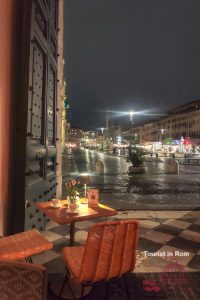
Good service at reasonable prices can be found at Vivi Bistrot in the Museo di Roma or in the numerous bars and restaurants behind the square. Bar del Fico, Ristorante Virginiae, the enoteca Cul de Sac, the Pizzeria da Baffetto and the Trattoria Giulio Passami L’olio are just some of the restaurants in the area worth mentioning.
A unique view over Piazza Navona can be enjoyed at Terrazza Borromini, with high prices and mediocre service. The entrance is at the back of the church of Sant’Agnese at Via di Santa Maria dell’Anima, 30.
The fountains
Piazza Navona is home to three magnificent fountains that are among the masterpieces of the Roman Baroque.
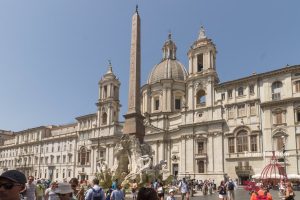
The central fountain is the Fontana dei Quattro Fiumi (Fountain of the Four Streams), created by Bernini between 1648 and 1651. The fountain depicts four allegorical figures representing the four continents known at that time: the Nile for Africa, the Ganges for Asia, the Danubius for Europe and the Rio de la Plata for America. In the center of the fountain rises an Egyptian obelisk from the 1st century BC, decorated with doves, the emblem of the Pamphili.
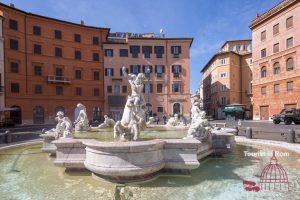
The northern fountain is the Fontana del Nettuno (Fountain of Neptune), designed by Giacomo della Porta in the 16th century, but completed only in the 19th century with the sculptures of Neptune and the Nereids.
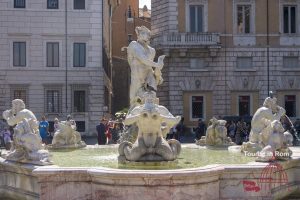
The southern fountain is the Fontana del Moro (Fountain of the Moor), also designed by Giacomo della Porta. The central statue of an Ethiopian squeezing water out of a dolphin was added later by Bernini.
The Palaces
The southern half of Piazza Navona is surrounded by elegant palaces, witnesses of Rome’s history and nobility.
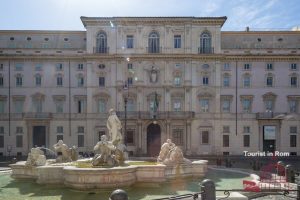
The most important palace is Palazzo Pamphili, which is located on the west side of the square and now houses the Brazilian Embassy. The palace was built between 1644 and 1650 by Girolamo Rainaldi and has a magnificent facade with a balcony above the central portal. The palace also has a beautiful courtyard with a garden and a gallery with frescoes by Pietro da Cortona. It is closely linked to the story of Donna Olimpia, who became rich and powerful as the sister-in-law of Pope Innocent X.
On the south side of the square is Palazzo Braschi, built between 1792 and 1814 by Cosimo Morelli and now housing the Museo di Roma. The palace has a neoclassical facade with a large portal and a triangular pediment.
Next to Palazzo Braschi is Palazzo Lancellotti, built in the 16th century.
The churches
Piazza Navona has two important churches, both belonging to the Baroque style. The most important church is Sant’Agnese in Agone, located on the west side of the square and dedicated to Saint Agnes, who is said to have been executed here in the 4th century AD. The church was built between 1652 and 1672 by Francesco Borromini and has a concave facade with two bell towers and a dome. The interior of the church is rich in marble, stucco and frescoes.
The other is the Sanctuary of Nostra Signora del Sacro Cuore, located on the east side of the square, which was originally a 13th century Gothic church. The church was rebuilt in the 17th century and has a Baroque facade with a portal and a triangular pediment. The interior of the church has a single nave with side chapels and a choir.
A little curiosity
Look at the statues of the Four River Fountain facing the Church of Sant’Agnese and you will discover with what horror they look towards the church.
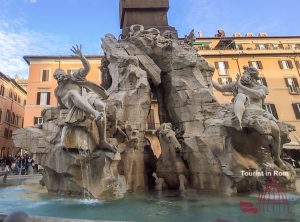
Bernini and Borromini were rivals and apparently when Bernini built the fountain he already knew that Borromini would get the commission to build the church. The popular saying is that the figures fear that the church will fall down, while St. Agnes on the facade of the church assures the figures that nothing will happen.
History
Piazza Navona has a long and fascinating history that dates back to ancient times. The piazza was built on the ruins of Domitian’s stadium, which was built in the 1st century AD and was used for athletic competitions. The stadium had a horseshoe shape with a length of 275 meters and a width of 106 meters and could accommodate up to 30,000 spectators.
In the Middle Ages, the square was used as a riding school, for games and carnival events, but also as a marketplace. The market continued until the 19th century, when it was moved to Campo de’ Fiori.
In the 15th century the square was built up with houses and palaces, some of which were built on the old stands. The square also became a venue for public events and popular festivals.
In the 17th century the square was transformed by the Pamphili family, who used the square as their private residence. Pope Innocent X (Giovanni Battista Pamphili) commissioned Bernini to build the Fountain of the Four Rivers, which was considered a symbol of his power and glory. He also commissioned Borromini to build the church of Sant’Agnese in Agone, dedicated to Saint Agnes, who is said to have been executed here in the 4th century AD.
In the 18th and 19th centuries the square was further embellished with the construction of Palazzo Braschi, which now houses the Museum of Rome, and the completion of the sculptures of the Fountain of Neptune and the Fountain of the Moors.
The square became the playground of the Romans with carnivals, races, hunts and all kinds of events. During the hot summer months, on weekends, the drains of the fountains were blocked and the square filled with water. The Romans played with the water and went around in boats. This was forbidden by Pope Pius IX in 1866.
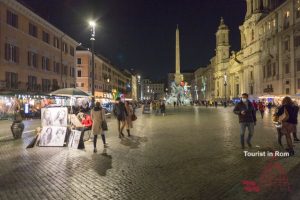
A small remnant of the earlier activities is the Mercato della Befana, the Witches’ Market, which takes place during the Christmas season. The only attraction among shooting galleries and plastic toys is the historic carousel, which has been used by many generations to celebrate Christmas. Gastronomy and mulled wine are not available at the market.
